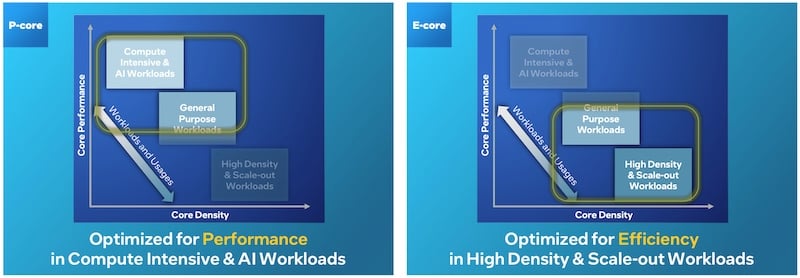Intel Reveals Two New Xeon Processor Lines at Hot Chips 2023
Intel’s newest Xeon processors are based on either performance cores (P-cores) or efficiency cores (E-cores), giving designers more flexibility to prioritize speed or power efficiency.
Intel has revealed two new Intel Xeon processors this week at Hot Chips 2023 to give designers new options for efficient server-level performance. As computationally heavy workloads such as AI and machine learning become more common, Intel’s new processors may help to optimize performance based on individual needs.

To meet the diverse needs of designers, Intel’s newest Xeon generation adds more flexibility when choosing a CPU. Image used courtesy of Intel
In previous Xeon generations, Intel listed performance per core as the primary metric for success, alongside power and space efficiency. With the new generation, however, designers can now trade raw performance per core for increased power efficiency for high-density deployments.
The two new chips, codenamed Sierra Forest and Granite Rapids, use new architectures to access higher performance and flexibility. This article dives into some preliminary technical details of the processors to give readers a sense of how they build on previous generations and where they may find use in future computing systems.
P-Cores vs. E-Cores
It’s no secret that modern processors, though quite powerful, are not optimized for every computing task. To add more flexibility and better average performance, many processors forgo niche hardware for a widely applicable computing system to address the needs of a broader audience.
Intel, however, has adopted a different approach starting with the 12th-generation Intel Core processors. Instead of using a common core architecture for each core, Intel developed performance cores (P-cores) and efficiency cores (E-cores) to address different processing tasks. Using this architecture, resource-hungry processes can use P-cores, while less intensive computing tasks can make use of the improved power efficiency of E-cores.
_and_E-core_(right)_1699224110720090112.jpg)
Intel P-cores offer improved performance on single-core processes, while E-cores can scale much higher thanks to the improved power efficiency. Image used courtesy of Intel
In high-performance workloads, some designers require maximum performance per core, while others need a more efficient solution for high-density deployments. The new Intel Xeon processors address this division in computing needs.
Choose Your CPU: Sierra Forest or Granite Rapids
Both the Sierra Forest and Granite Rapids chips are built on the Intel 3 process node and use a modular SoC architecture that accesses different nodes for each chiplet. Where the Xeon chips differ, however, is in the computing circuits built into the silicon. The Sierra Forest chip will make use of E-core architectures, while the Granite Rapids chip will leverage a P-core architecture for improved core performance.
This difference in hardware will ultimately allow each of the Xeon processors to address unique computing needs. The Granite Rapids chip can provide designers with higher levels of performance and less constraint on TDP or power efficiency, evidenced by a 2–3x performance boost for AI workloads.

The two Intel Xeon chips are suited to different applications, allowing designers to prioritize efficiency or speeds as needed. Image used courtesy of Intel
The E-core-based Sierra Forest chip provides a 250% better rack density and 240% improvement in performance per watt than Intel's Sapphire Rapids chips. While it may not beat Granite Rapids in raw speed, Sierra Forest improves overall power efficiency.
Flexibility in the Data Center
Intel expects to roll out Sierra Forest and Granite Rapids chips in the first half of 2024, at which point Intel engineers and designers can evaluate the efficacy of the chips and the Intel 3 process. While Intel's reported performance boosts may not be valuable to every use case, the advancements will indeed improve performance per watt and throughput for server-grade applications.
As Intel prepares the 5th generation of Xeon processors for launch, designers can get a better idea of how the move to the Intel 3 node will affect the performance of the Xeon line.






